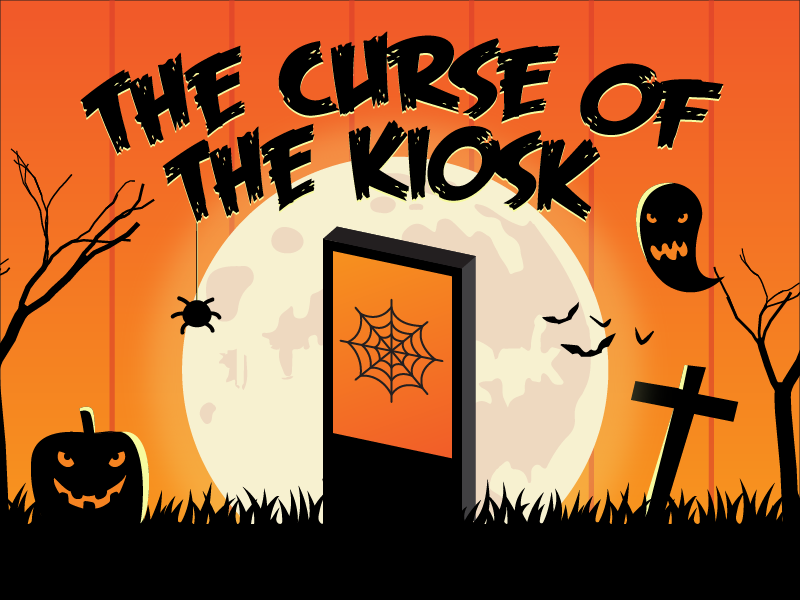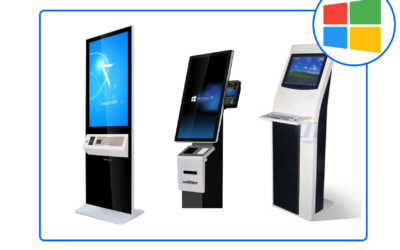Booo….. It’s Halloween time and every year around this time, some of us try to take stock of the demons that plague us, our families, our business and sometimes our industries. One set of demons that have been thinking of lately are related to the touch kiosk market. We started targeting this market sometime last year when we first rolled out our touch screen bulletin board kiosk for employee and customer engagement as a result of feedback from some of our early adopters.
What I have been observing about the Kiosk market is that in spite of seemingly a perfect storm of market forces that could propel this market, the YoY sales growth seems to be modest at the best for the market as a whole. So I wanted to take some time get my thoughts together and hopefully trigger some good conversations in the process.
The perfect storm that is not meant to be:
So what the the market forces that in theory should be favorable to the kiosk market? Well here you go. This is not meant to be a comprehensive list but broad brush strokes. Let me know if you feel I missed anything major.
Low screen prices:
It’s safe to say that the prices of flat screen TVs have bottomed out. Last thanksgiving I got a modest 55’ 4K TV for a lowly $299 plus tax. Yes, I admit, I am one of those. Any lower and the manufacturers will have to pay us to use their TVs.
Consumers have obviously benefited in lower TV prices as a result of multitude of factors but the primary one being tremendous advancements in display technology coupled with equally precipitous drop in manufacturing costs. It’s like the Moore’s law on steroids.
Success of Social Media:
Social Media has not only given as a new way to communicate but has changed our culture to the core. Now-a-days it’s perfectly okay for businesses and institutions to not have to carve perfectly crafted messages with high production value but their customers are fine getting a simple social media updated that is a simply crafted in text and may be an image or two. Gone are the days when websites, print & PR releases were the primary the ways that businesses interacted with the customers. Social media has eaten mass communications. But that simplicity of communication seems to have not translated to kiosk based communications.
SaaS and Cloud Movements:
SaaS business models and cloud hosting services have more or less completely disrupted the traditional licensing based business models that have been the mainstay for much of our adult lives. Businesses shall not only be able to try out kiosk systems more easily, but shall be able to break down costs into more manageable monthly or yearly payments. More importantly however, customers should not be worried about deployments, hosting, development and maintenance of these kiosks anymore.
If you add this up, you shouldn’t be at fault to assess that any market that uses a product made with flat screens & software, is bound to tremendously benefit from the advances and cost reduction in these underlying market forces.
However, you would be wrong. The kiosk market while growing at a healthy 25-30% rate Y-o-Y has failed to make up a stellar success story that consumer tvs, smartphones, Social media and SaaS products show us. Just anecdotally speaking, not every business that you walk into has a kiosk OR not every workplace you have worked at there is an employee information center to help you find your bearings.
The Curse:
It’s not that there is no use for them, our experience in working with over 3000 organizations confirms otherwise. However a combination of reasons have so far colluded and hindered the adoption of kiosks and other stakeholder interfaces a real common place.
Here’s my list of key challenges in kiosk adoption.
The Kiosk CMS
Or the underlying insight that leads to creation of CMS based usability architectures. Every kiosk system out there is some combination of backend end CMS editor to design & develop “pages” or “applications” that the kiosk’s interface is made of. This is how most of the kiosk architectures were built in mid 90’s onwards and you might be able to tell, this bears striking resemblance to the trusty wordpress CMS architectures on the wider web.
This made a lot of sense in the 90s. Afterall wordpress was this shiny new thing which allowed anyone without any coding capability to build a decent looking website using templates and freely available plugins. However, about 20 long years in, the web world has moved on. I am not here to say that wordpress is any less popular (after all this post will be published on our wordpress site) but there are many options for users to choose from. Social publishing platforms like Linkedin and Medium have not only made it easy for users to post their thoughts but also get many more eyeballs using a curated social push compared to what they would otherwise get with just SEO and link building.
While traditional CMS platforms can still be great to build solid webpages, online SaaS based web platforms like Wix & Weebly are extremely popular now. The point I am making is, unless you are designing an extremely specific UI, most kiosk uses could be made cheaper, easily deployable using a standardized SaaS based UI that simplifies content creation and upkeep for communications managers. At HootBoard, we do this by allowing administrators to update informational content using a social media like posting process which is much simpler and nimble.
Undemocratic and bottlenecked
Today’s’ kiosks systems are inherently undemocratic which leads to operational bottlenecks in keeping the content updated. Due to the complexity of the CMS system and lack of simple moderation features, updates to content can be only be made by a select few. This means every small update has to go through a process and queued till the persons operating the kiosk system have time to make changes and schedule a release.
Disconnected from other systems
Apart from where the security and single use concerns are paramount like ATMs and airport check-in systems, having a kiosk more or less disconnected from rest of the API world is counterintuitive. Again this was just fine about 20 years back when the CMS based systems were created. The API based app economy like the one we have today was not the mainstay back then.
However, in today’s day and age, with extremely thin to no support of integrations to third party applications is more of a hinderance.
Outdated and uninteresting information
All the above issues mean that the content on CMS based traditional kiosks doesn’t change often. Which really means once people know what’s on the kiosk, there is no need to re-visit the kiosk again.
This really leads to the couple of most pressing issues in adoption I have with traditional kiosks.
Unromantic and transactional
Kiosks of the yesteryears are mostly transactional monoliths that allow a single or only few actions. Now this is great when you have high frequency critical transactions like printing boarding passes at the airport. However, this proves to be not so cost effective when they are just used for information delivery.
Additionally, reasons stated in previous few sections, the content is extremely static and frankly boring as mentioned previously.
All of this leads to my biggest usability gripe about kiosks as a tech family product in general. Have you heard of anyone “love” their kiosks like they love their “iphone”? Yeah, I thought so. They are there so one could get their s*** done and the organization in question can let go a few people to save costs. That’s it!
No long-term relationship
But the damage doesn’t stop there with kiosks. Today, if you are a business which by nature draws people through your buildings, your communication managers are putting a lot of effort on social media with a hope to “build a relationship” with your prospects. But the there is no way to rope in your own customers who are actually in your building today. And the kiosks of the yesteryears are NOT helping with that.
With HootBoard’s social bulletin board kiosk, it’s not only easy to update content, but your customers can actually “FOLLOW” your kiosk on to their HootBoard app. This way they always have access to your content from your kiosk right on their mobile phones. That way they engage with it anytime and get notified when something gets updated.
Rigid business models
Kiosk vendors of the past have had a large upfront feed for hardware and software since they want to “cash out” for their sale and lock people in. Also these were mostly based on a CMS + On device player model where this was the only model that would make sense. This really means tremendous risk for the purchasing organizations and the onus of success lies with the buyer. Heard of “Buyer Beware”?
Well this has to change in the future. Apart from a small monthly fee, HootBoard’s bulletin board kiosks charged based on engagement. That means the purchasing organization is only paying if their users are using the system. We are confident in our product and we know what good usability of a kiosk look like. So we are willing to take the risk and continually improve our product to maximize engagement. We know this is a win for our clients and when our clients react so positively as they usually do, it’s a win for us.
Alright, enough from me. Do you agree that the kiosk market has floundered for long? What are your reasons? If you are a customer or some one thinking of buying kiosk systems, what has been holding you back? Let’s talk, mention me @sshahade on twitter and let me know your thoughts, or if I missed anything.
Happy Halloween!




